Professional burnout in IT (results of the research "My Circle")

Last October, My Circle was invited to RIF Voronezh to make a report about professional burnout among IT professionals. As always, we approached thoroughly, conducted a survey among the users of My Circle and Habra on this topic and today we are happy to share our research. Let's see how IT professionals are subject to burnout, what signs distinguish it, what reasons they indicate, how they leave it.
Most of the questions of the questionnaire were based on the materials of the master class of Natalia Dzeruzhinskaya, doctor of medical sciences, professor, psychiatrist of the highest qualification category, conducted by her in the framework of the Stratoplan School of Managers ( videos of 5 master classes of the school ).
Before diving into diagrams and their interpretation, let us say at once why it is important to know as much as possible about professional burnout, to be able not to fall into it and not let others do it.
As we learned, more than 50% of IT professionals have experience of professional burnout, and half of them went through this experience 2 or more times. For an employer, such a burnout of employees has quite serious consequences: up to 20% of employees are regularly in a similar condition, only 25% of burnouts remain at the same place of work. So, quite a large part of the staff works extremely inefficiently and prevents others, plus constantly need to invest in recruiting and adapting new employees to replace the burnt ones. If the employer learns how to manage the burnout process, then he can save a lot of material and moral strength for his company.
What is professional burnout
For a start, let's remember the definition of professional burnout. We gave the same definition to everyone who began to pass our survey in order to ask subsequent questions based on this common understanding.
Professional burnout (eng. Burnout) - the complete or partial loss of efficiency in the workplace due to increasing emotional and then physical exhaustion. It is manifested by increasing indifference to their duties and what is happening at work, the growth of negativism towards both clients and colleagues, a sense of their own professional failure , dissatisfaction with work.
According to psychologists, professional burnout works like a psychological defense that takes the body into an energy saving mode, whose resources are depleted to adapt to permanent stressful situations.
Who participated in the survey
About 2,500 people took part in the survey, according to socio-demographic characteristics, about the same as in our previous studies: 50% were developers, 80% were men, 80% were between 21 and 35 years old, 25% were from Moscow.
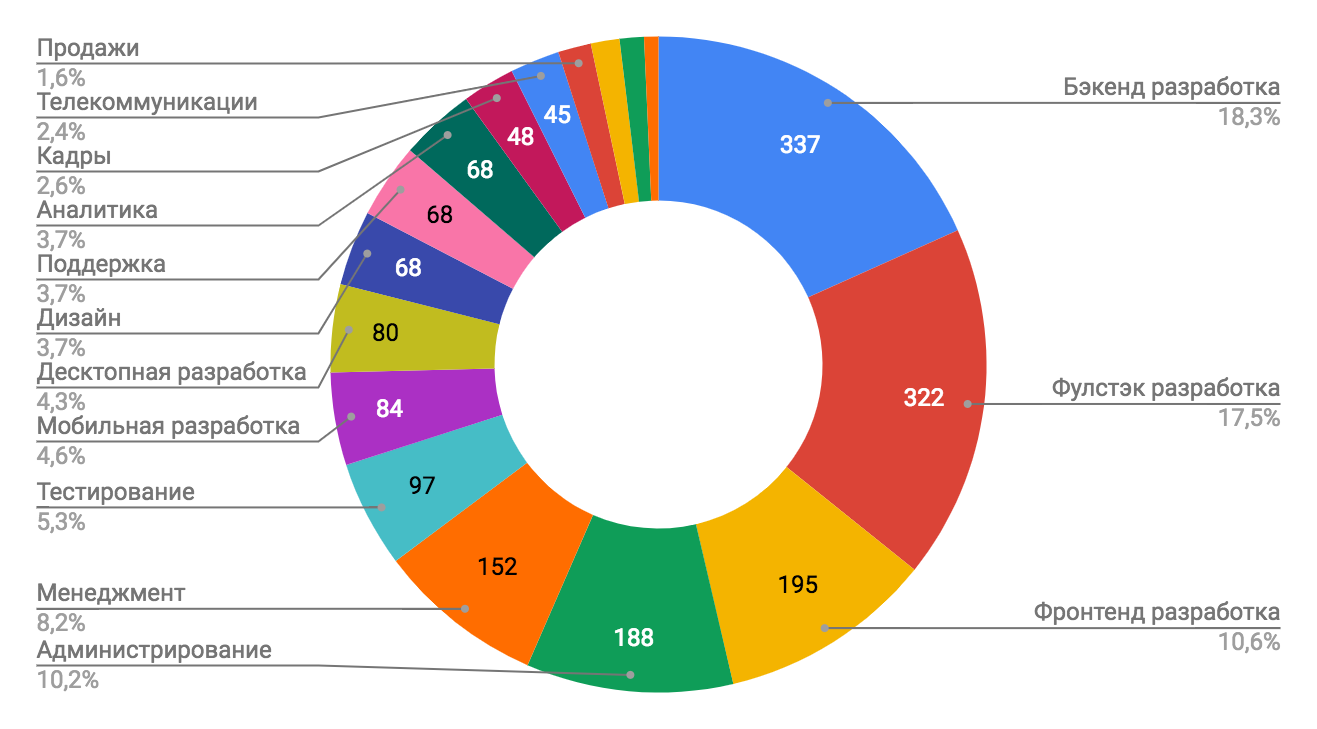



Burnout experience
To begin with, we learned how much professional burnout experience is common among IT professionals. To get a more accurate picture, in the question we clarified how strong the burnout was: was there a weekend or a holiday enough to get out of this state, or didn’t even have a holiday?
We assumed that professional burnout, which psychotherapists are talking about, we will consider only the experience in which even a vacation was not enough to restore our strength. And in all subsequent diagrams, we call such a state a strong burnout and conduct analytics only for those respondents who have noted this experience.
Has professional burnout happened to you personally?
It turned out to be a rather serious figure: more than 50% of the respondents had experience of strong lightening, and this figure for women exceeds 60%.
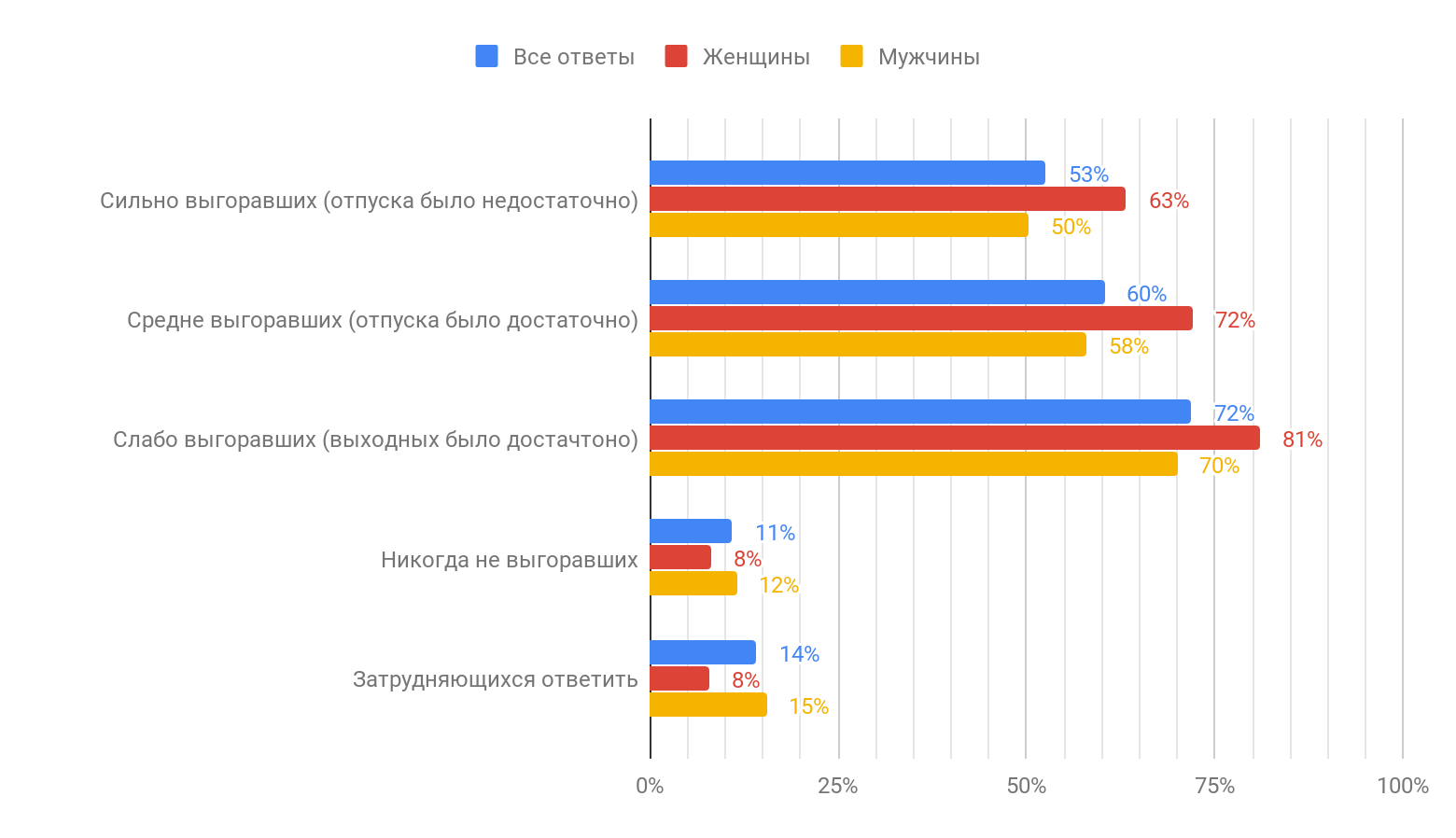
If we split the respondents by age, we see a more serious picture. In respondents aged 25–40 years, experience of strong ignition occurs in 50–60% of men, and in 70% of women.
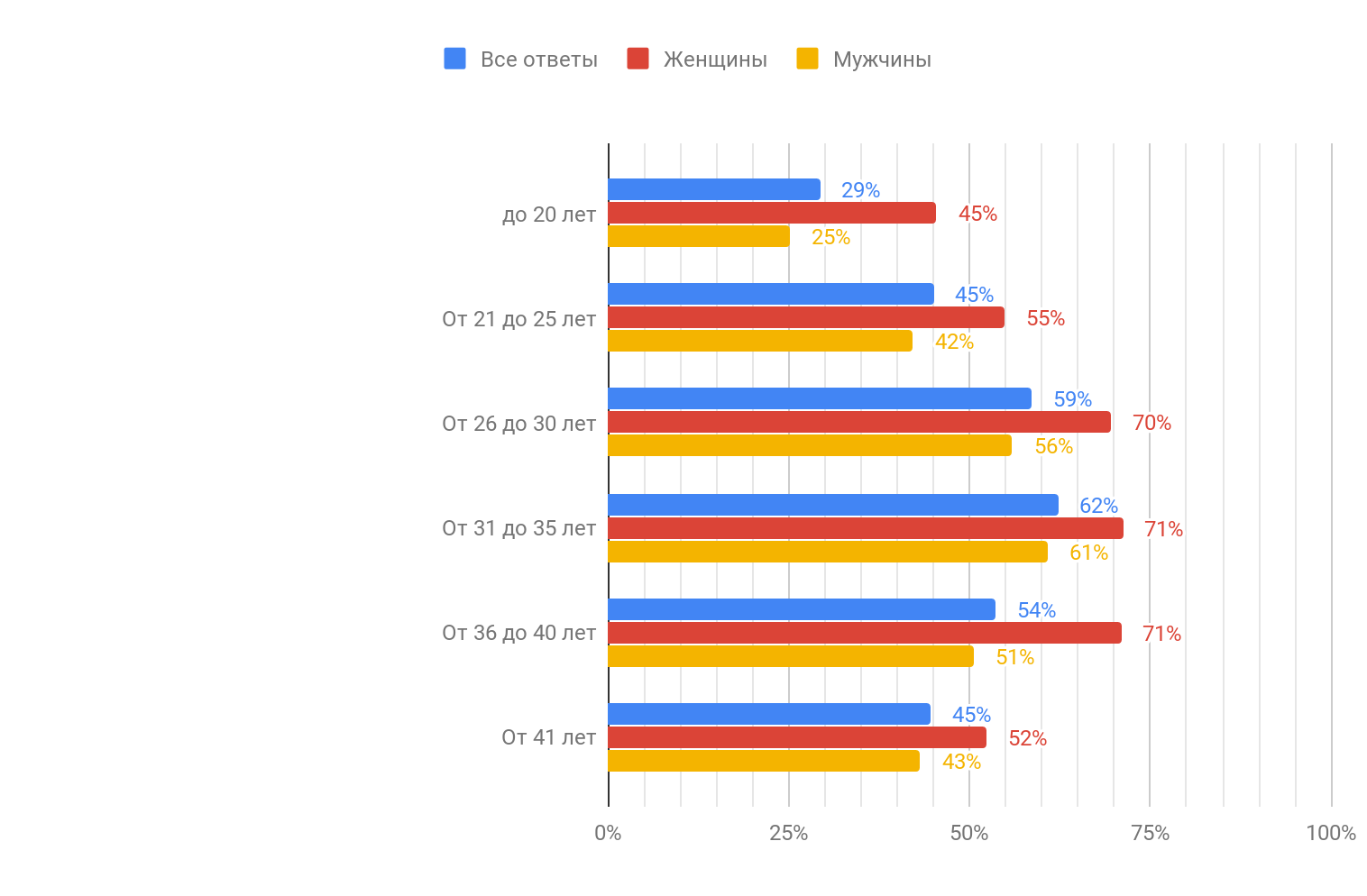
How serious are these numbers? To answer this question, it will be right to compare the IT industry with other areas of human activity. As we learned from the Dzeruzhinskaya master class , according to 2009, the following specialists are most prone to burnout: women teachers are 71% of them have similar experience, then surgical nurses go next - 60%, then social workers - 55%.
As you can see, women from the IT industry in terms of burnout frequency can "argue" with such traditional emotionally heavy industries as pedagogy and medicine!
Has a strong professional burnout happened to you personally that even a vacation was not enough?
Let's look further, what are the most common factors affecting the frequency of professional burnout. We asked the following question: at the time of your strongest burnout, how many years did you work in this company, what kind of activity and type of ownership was this company in, what city did you live in and how old were you then.
Since these questions were asked only to those who had at least some experience of burnout, we measure the frequency of severe burnout not among all respondents, but only among those who had such experience (among 75%). Therefore, do not look at the absolute figures of burnout, and compare them with each other.
Among all those who had burnout experience, 70% experienced severe burnout.

The longer a specialist works in the same company, the more likely he is to burn out much. It can be seen that the turning point occurs in the second year of work.
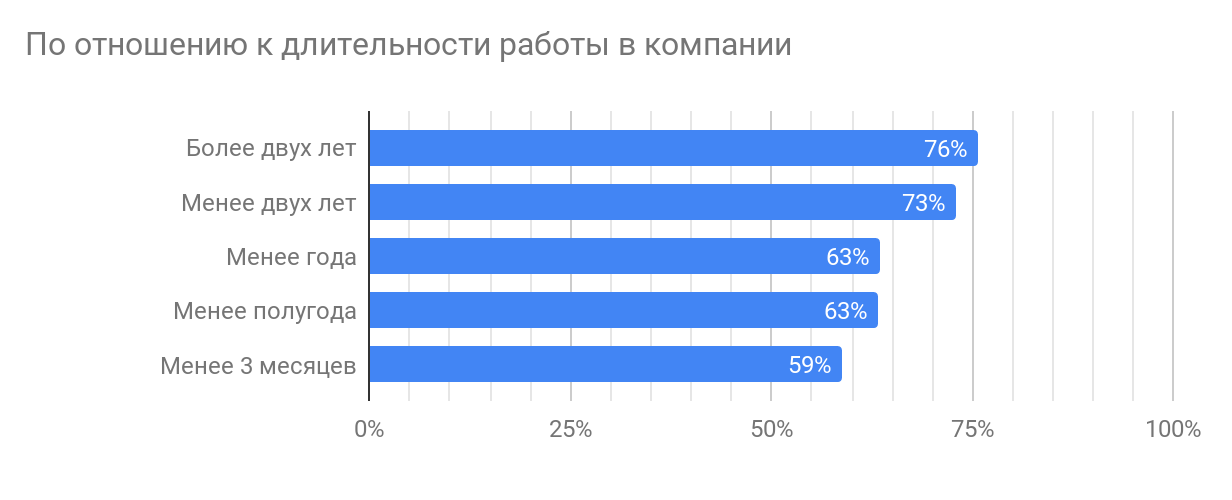
The frequency of severe burnout is almost independent of the company's business. Those who work in consulting companies have a higher chance of fading.

Most often burn out in private companies, less often in state and their businesses, least of all those who are engaged in freelancing burn out.
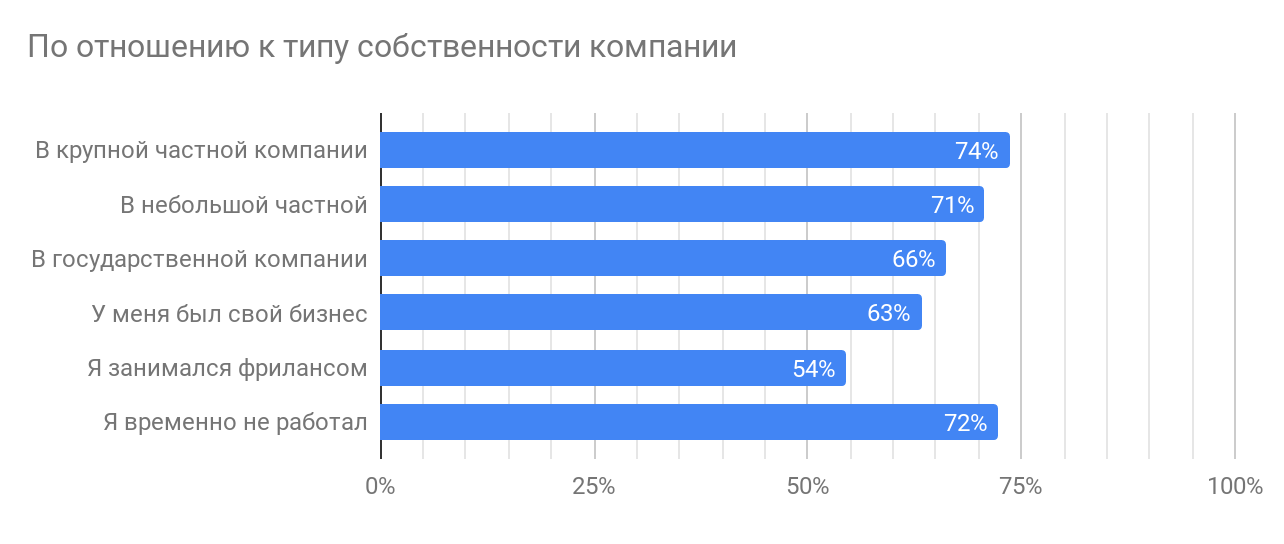
In Moscow and St. Petersburg burn out more often than in other cities of Russia.

When we analyzed the burnout frequency depending on the current specialization, we saw that different specializations have different age composition. For example, in management, the average age is 31 years, and in game development it is 26 years. But, as we saw earlier, the burnout frequency strongly depends on age: a person who has lived more has a higher chance of facing burnout. Therefore, when calculating the burnout frequency depending on the specialization, we took answers only from a narrow age group from 25 to 35 years to remove the influence of age and leave only the influence of the specialty itself.
And got the following picture. The most risky burnout specialization in IT is sales, management and marketing. And the least risky are HSU, tech support and mobile development.
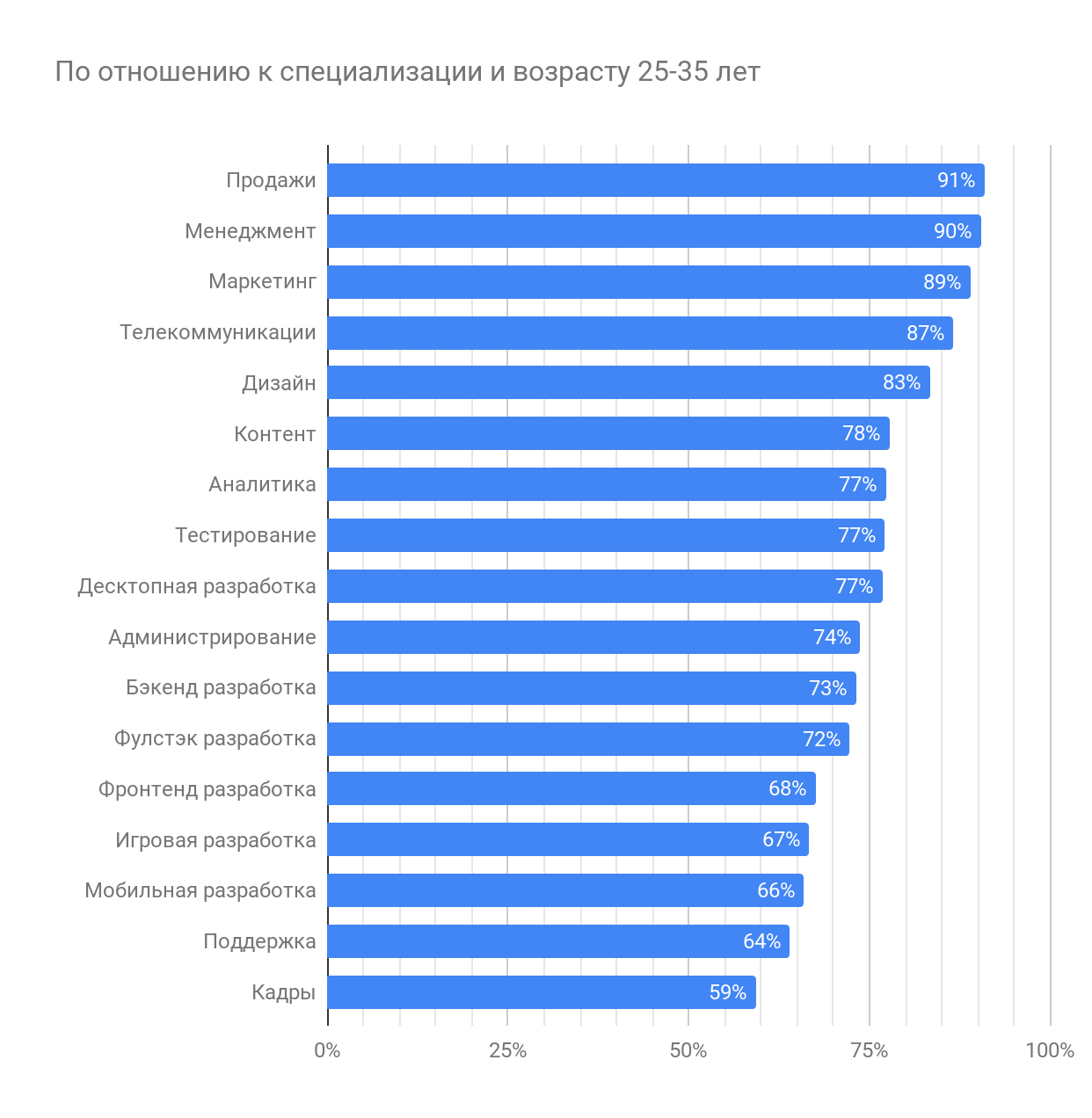
How many times have you had a strong professional burnout?
And how often does a strong lightening happen for those who have noticed a similar experience? It turned out that almost half of this experience was not a one-time, but was repeated two or more times.

What ended your attempts to exit from a state of strong professional burnout?
The most important question from the point of view of the employer, and what is the risk of employees getting into a situation of professional burnout?
- From the survey, we learned that 18% of respondents are currently in a state of severe burnout, which means they work very inefficiently (they are indifferent to their duties, negatively disposed towards colleagues and clients, they feel they are not fit)
- But the most unpleasant thing is that of those who went through the experience of a strong burnout, only 25% kept their former place of work (among women, even less - only 18%). This means that the employer was forced to spend the resources of his company to replace such employees with new ones.

Young people under the age of 20 are much more likely to retain a job in the event of severe burnout, for other ages the likelihood of maintaining a job is about the same. The exception is the age of 31-35 years: during this period of life the probability of saving the place of work is somewhat lower.
At the age of 36-40 years, the type of activity is also changing more often than other ages when losing a job as a result of burnout.
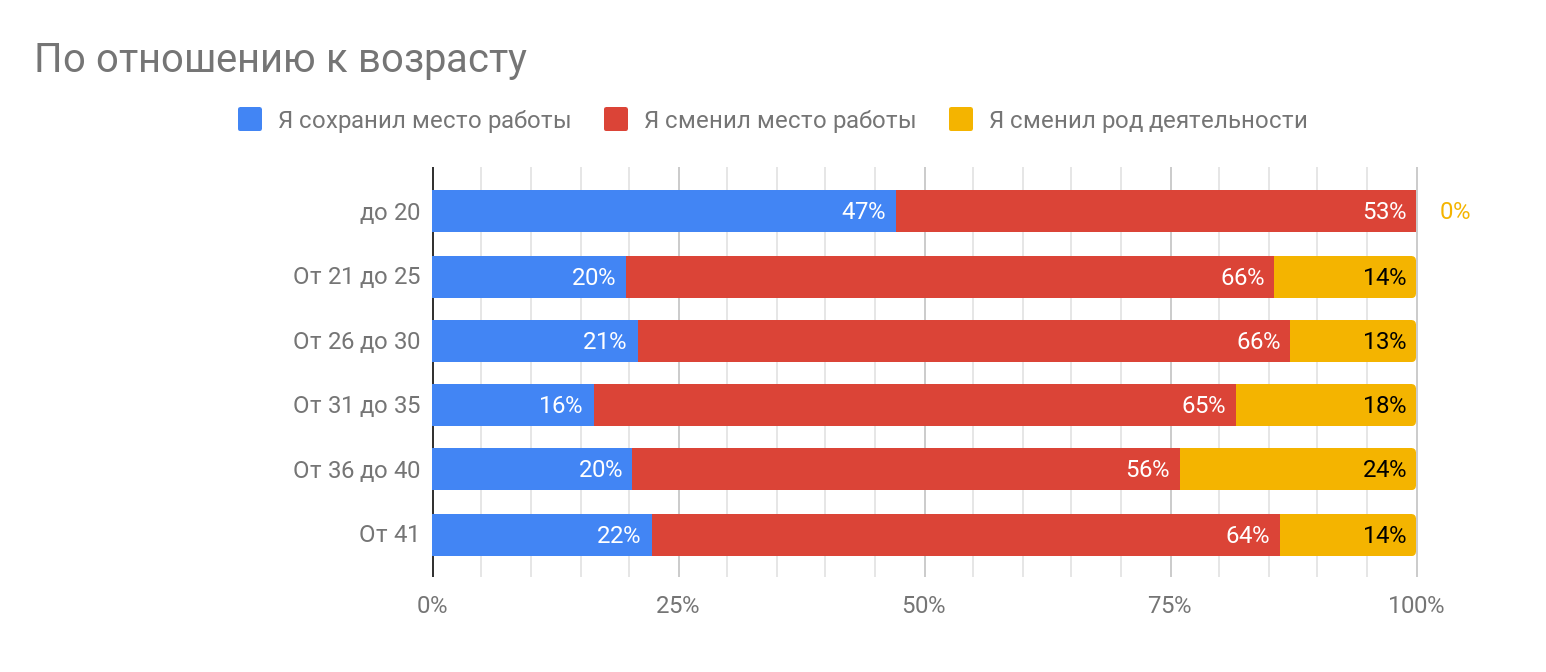
The most risky job-loss specialization is marketing and analytics: none of the respondents kept their place of work in these specializations after their burnout. Then there are sales and technical support: only about every tenth retains a job in these specializations. A curious observation: after burning out in sales in more than half of the cases, not only change jobs, but also change the type of activity itself.
More often than others, they keep their jobs in mobile development: almost 30%.
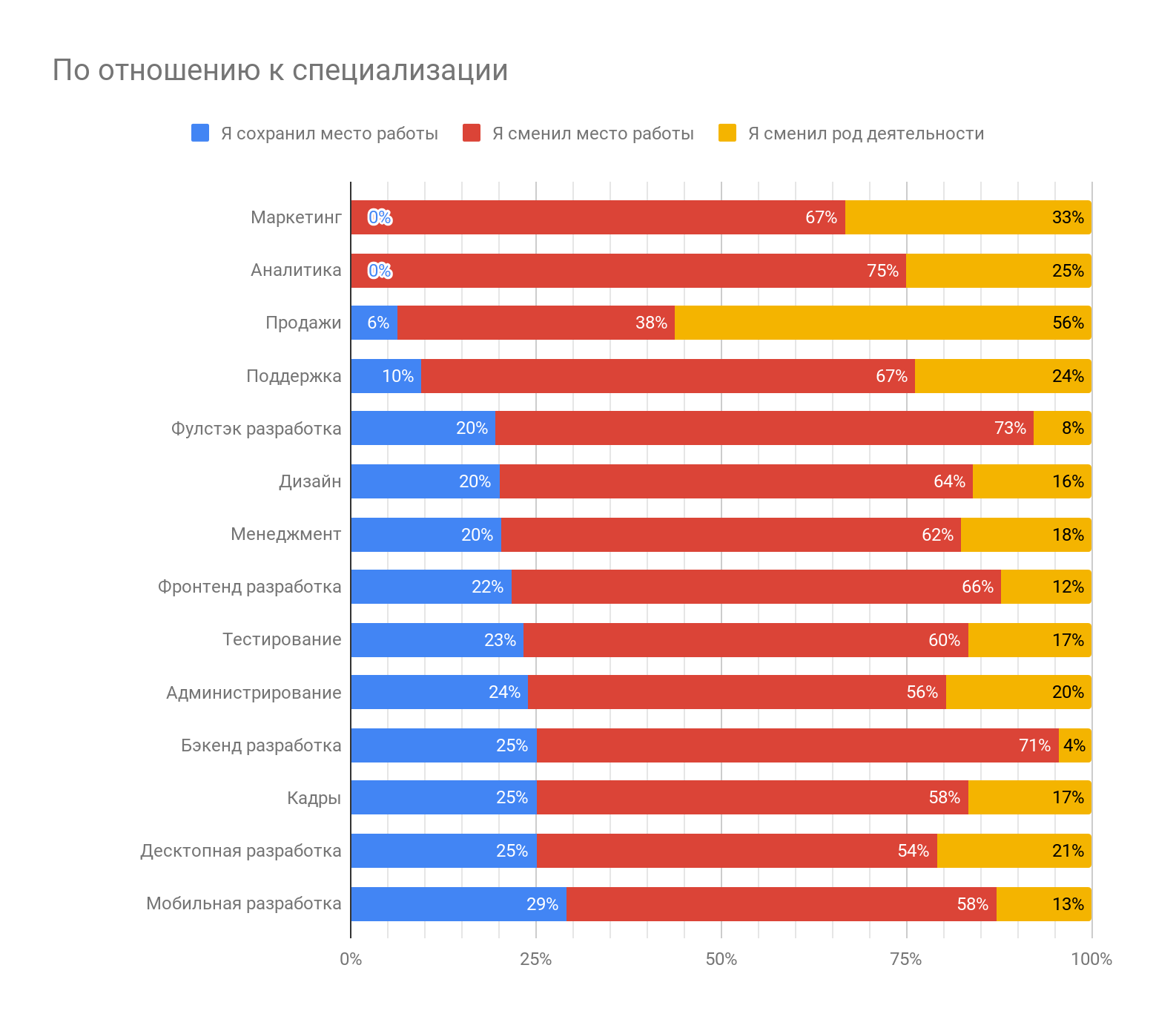
Professional burnout with colleagues
The problems of professional burnout are not limited to inefficient work and the dismissal of burned-out employees. If someone burns out nearby, this also affects the overall efficiency of labor. Half of the respondents stated that they had observed professional burnout with colleagues. Every third noted that the burnout of a colleague prevented him from working.


Signs of burnout
How can you recognize that you or your colleague are close to professional burnout and take measures in time to avoid being in it? Let's talk further about the signs of professional burnout, they are all divided into 5 groups:
- Physiological;
- Emotional;
- Intellectual;
- Behavioral;
- Social.
Which of the following physiological signs did you observe in your burnout state?
The main physiological symptom of a strong burnout is a constant feeling of fatigue and exhaustion: almost all respondents who have experienced a strong burnout have called it. Following are sleep disturbances, headaches, decreased sexual activity and changes in appetite: these symptoms were called from one third to one half of the respondents.
The diagram clearly shows how much more painful women experience the moment of burnout, they have much more often than men almost all the physiological symptoms listed.
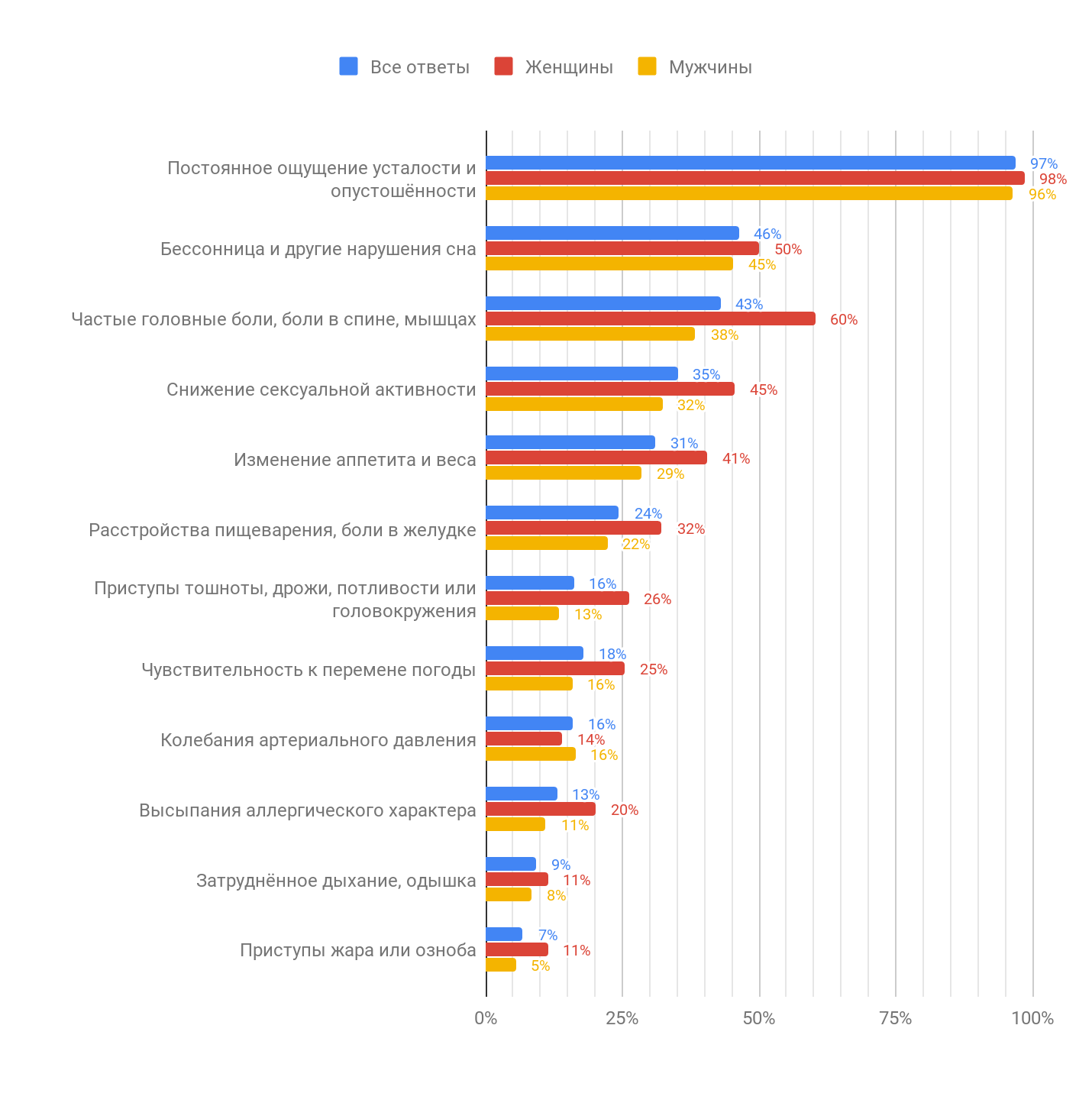
Which of the following emotional signs did you observe in your burnout state?
The main emotional sign of a strong burnout is the loss of motivation and indifference: it was also called by almost all respondents with a strong burnout. Following are dissatisfaction and disappointment in oneself, an increase in boredom and apathy, a sense of unfulfilled debt, irritability and aggressiveness, a feeling of helplessness: more than half of the respondents named these signs.
Again, we see that women experience burnout much more sensitively: 60-80% of women who survive burnout indicate all the listed signs.
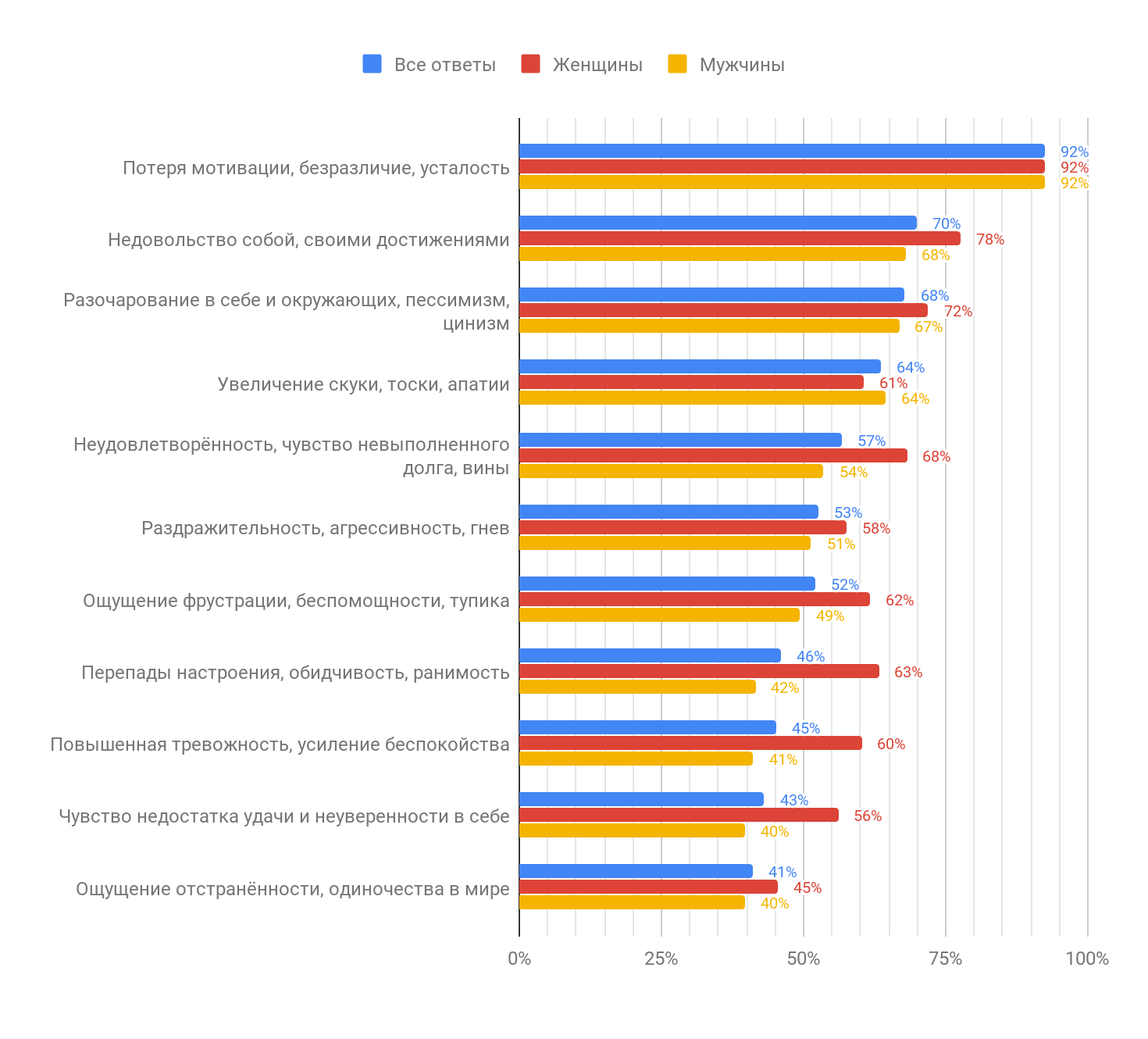
Which of the following intelligent features do you observe in your burnout state?
The main intellectual sign of a strong burning out is problems with concentration of attention and memory, inability to concentrate and make decisions: it was called by 80% of respondents with strong burning out. Following are a decrease in interest in new ideas and alternative approaches, a constant return to the same thought: 40-50% of respondents named these signs.
For intellectual signs of burnout there is not much difference between men and women.
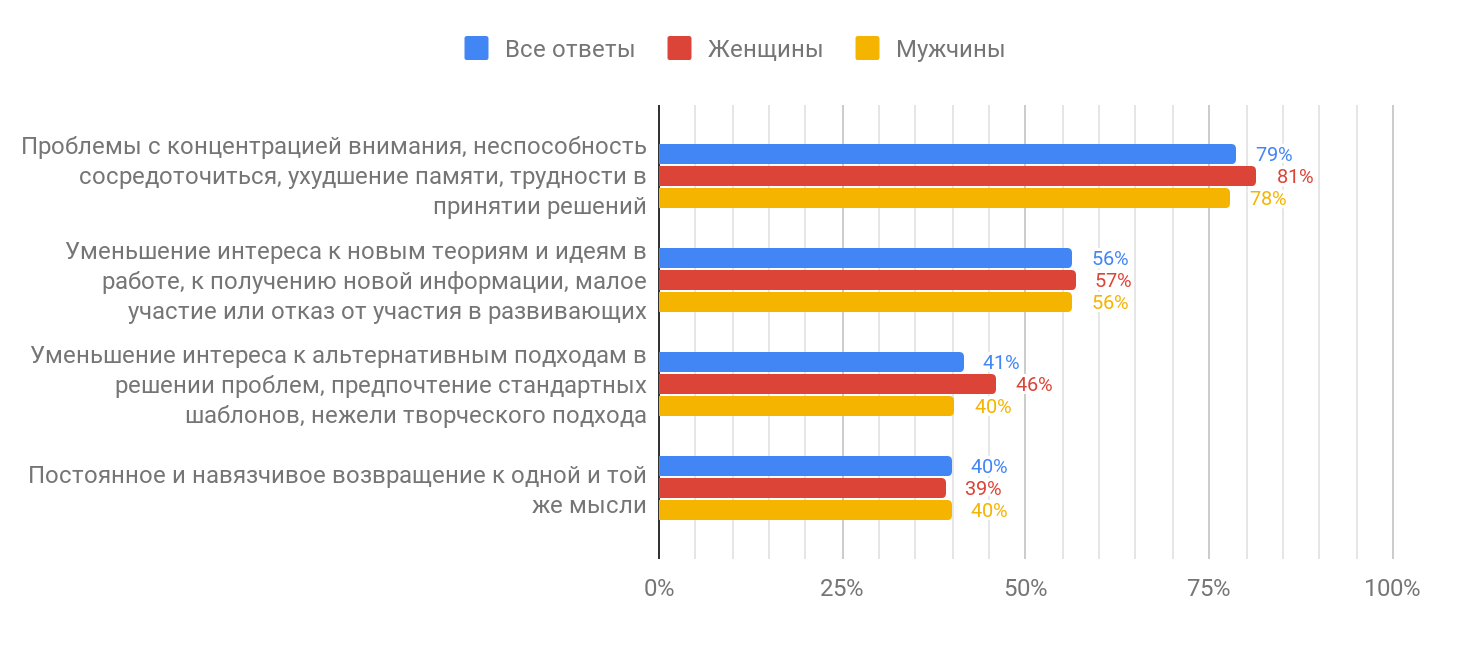
Which of the following behavioral signs did you observe in your burnout state?
The main behavioral signs of severe burnout are the desire for rest during work, the formal execution of work and the long achievement of goals: more than 70% of respondents named these signs. Further, there are violations of the working mode, an increase in the number of errors, a feeling of lack of time, a sense of hyper-responsibility, a negative attitude towards professional perspectives: from one third to half of the respondents named these signs.
In women, only half of the signs are indicated significantly more often than in men.

Which of the following social traits did you observe in your burnout state?
The main social signs of a severe burnout are a decrease in social activity and a loss of interest in leisure: these signs called two thirds of the respondents. Next come the distancing from colleagues, an increase in conflicts, a feeling of isolation and a lack of support from friends and relatives: from one third to one half of the respondents named these signs.
In women, all signs are indicated slightly more often than in men.

Let's summarize the intermediate results and list the main signs of professional burnout, which are found in the overwhelming majority of people:
- Physiology : constant feeling of fatigue and exhaustion, sleep disturbances, headaches.
- Emotions : loss of motivation and indifference, discontent and disappointment in oneself and others, increasing boredom and apathy.
- Intellect : problems with concentration and memory, inability to concentrate and make decisions.
- Behavior : the desire to rest while working, the formal execution of work, the long achievement of goals.
- Sociality : reduction of social activity and loss of interest in leisure.
Women are experiencing a state of burnout noticeably stronger than men, especially by physiological and emotional symptoms. Perhaps this can explain why women as a whole burn out more than men (63% vs. 53%).
Causes of burnout
It is known that in order to overcome a disease, it is necessary to treat not its symptoms, but its causes. Let's see, and what leads to a state of professional burnout? All reasons can be divided into 3 groups:
- Chronic emotional activity;
- Destabilizing organization of activity;
- Problems of professional growth and working conditions.
What do you think, what emotional tensions led you to a state of burnout?
The psychologically difficult contingent, the uncontrollability and intensity of communication are most often called the emotional causes of professional burnout: from one third to one half of the respondents indicate these reasons.
Women are a little more likely than men to name all the listed reasons and are noticeably more sensitive to the intensity of communication.
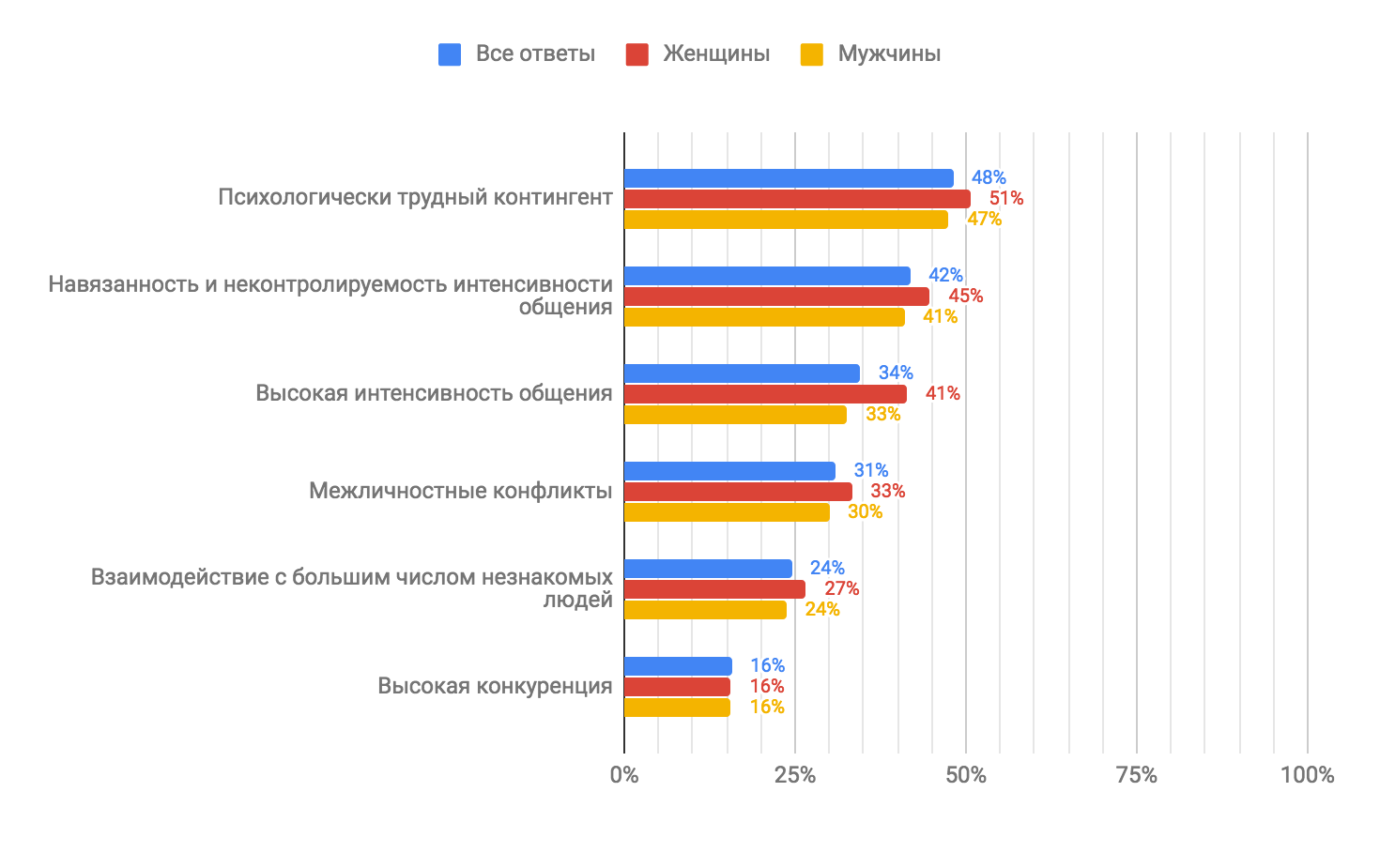
It is curious to see what emotional reasons are called more often than others in different IT specialties. We see that in sales and Euchar, the intensity of communication comes to the top position, in content and marketing - the uncontrollability of communication, and in mobile and game development - interpersonal conflicts.
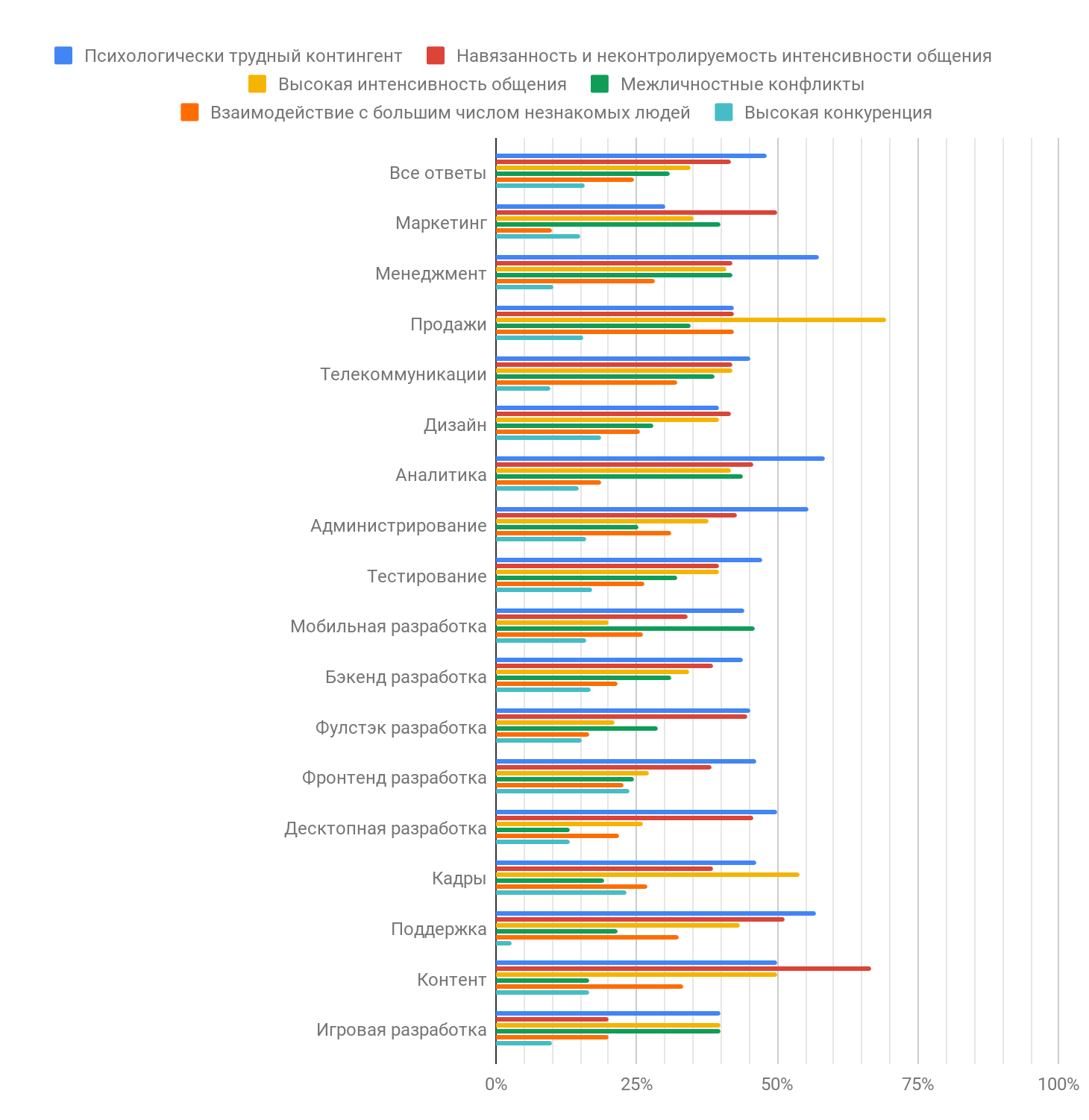
What do you think, what destabilizers of activity led you to a state of burnout?
Most often, organizational reasons for professional burnout call unclear task setting, ambiguity in the distribution of responsibilities and the lack of concerted actions: from half to two thirds of respondents indicate these reasons.
Women are almost no different from men in the frequency of naming one reason or another. But it is clear that they are noticeably more sensitive to excessive workload and less sensitive to routine activities.

If you look at individual specializations, then sales, Euchar and content come to the fore in the organizational reasons for the lack of concerted actions, in management, marketing and mobile development - an unclear distribution of responsibility; in testing - monotony of work;
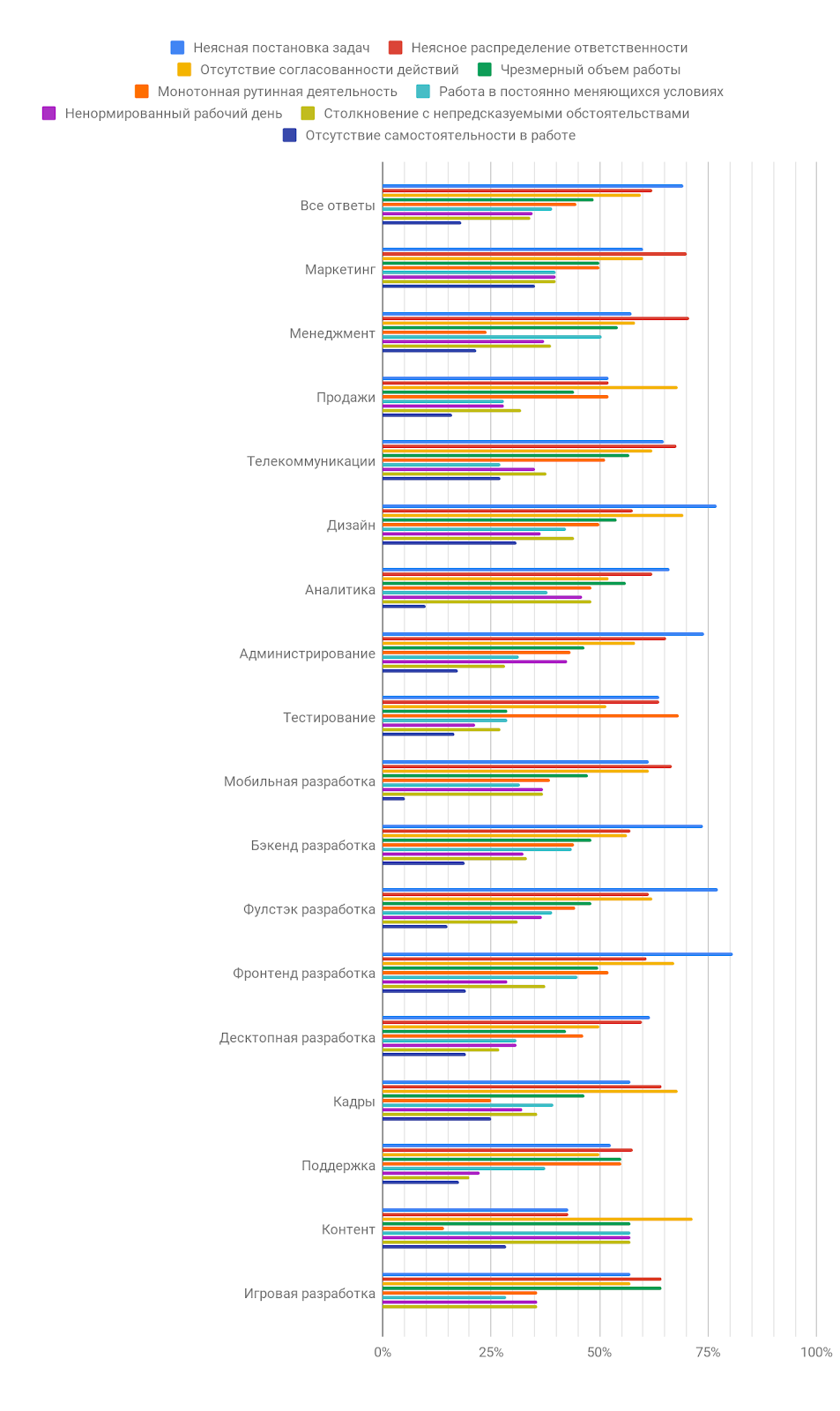
What do you think, what problems in working conditions led you to a state of burnout?
Most often in working conditions, the reasons for professional burnout are called insufficient psychological and material rewards for work: more than half of the respondents indicate these reasons. There is a lack of time for rest, disagreement with the values of the organization, insufficient management support, high expectations from the results of their activities: from one third to one half of respondents name these reasons.
It can be seen that women are much more sensitive than men to psychological encouragement and support from the management and a little less sensitive to disagreement with the values of the organization.
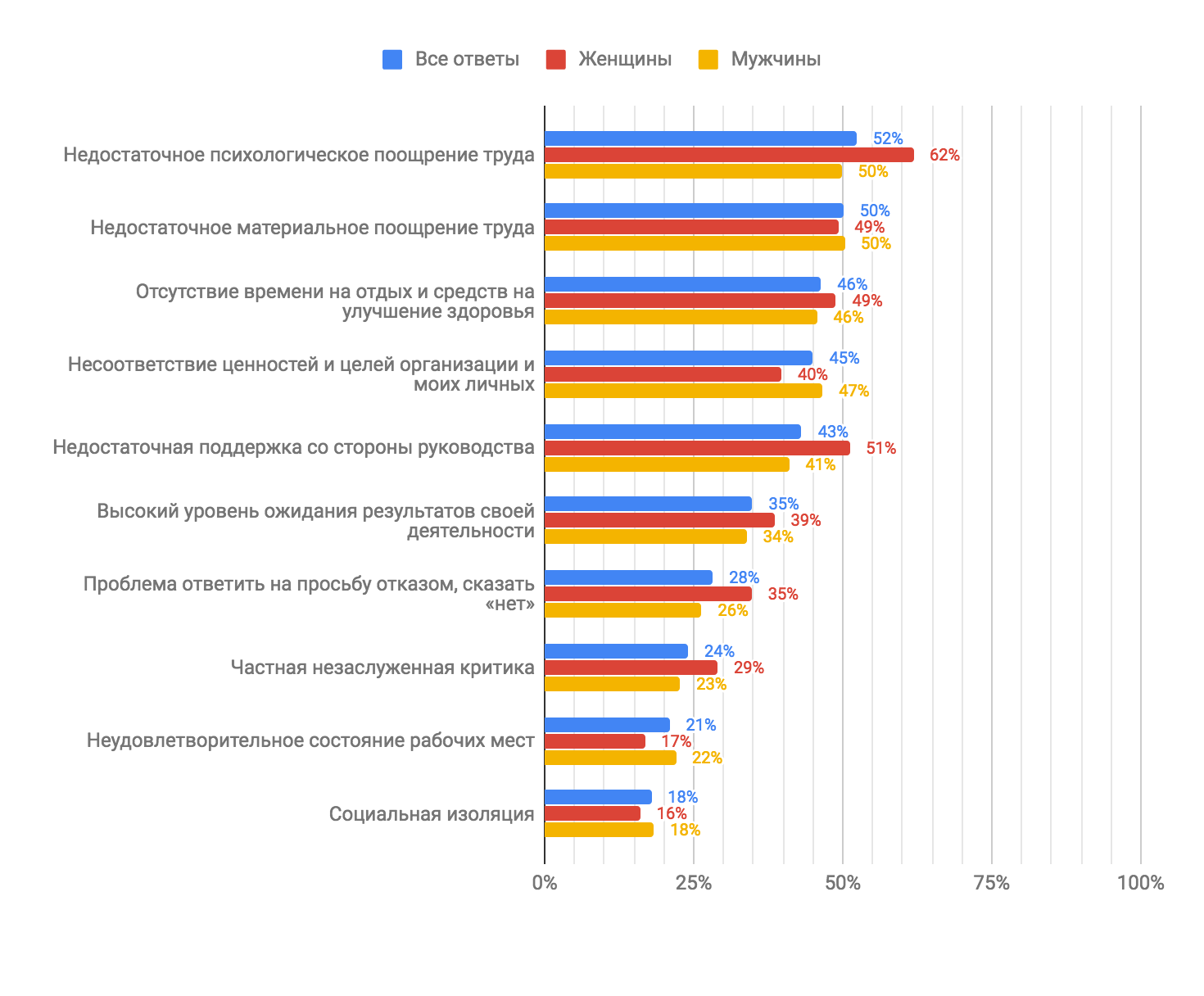
With a view to individual specializations, we see that in administration, Euchar and technical support, the most acute problem is the material underestimation of the contribution of employees; in marketing, design, content and management - there is an acute issue of support from management, in mobile development, they more often overestimate the future results of their activities.
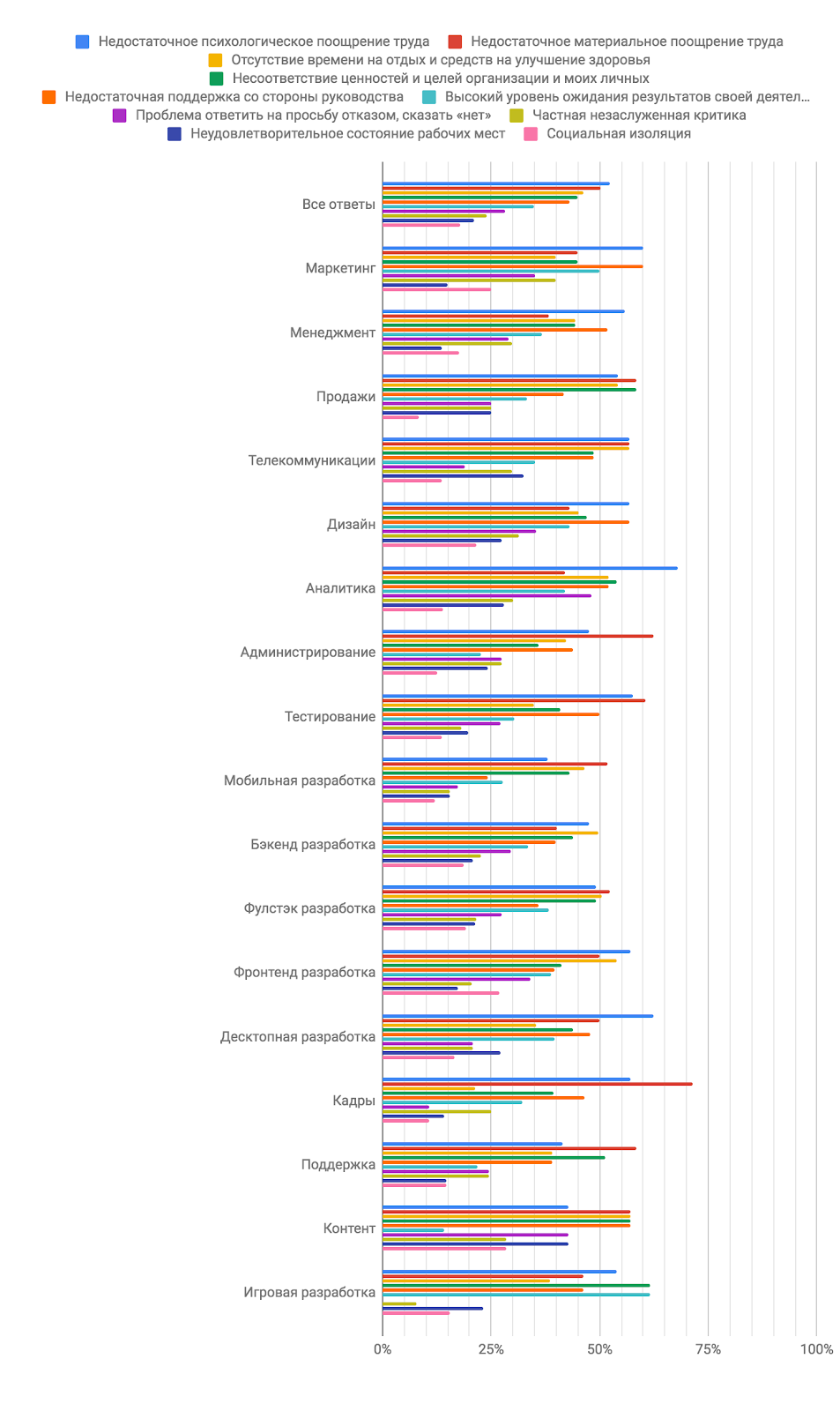
Let's summarize the following intermediate result and enumerate the main causes of professional burnout that occur in the overwhelming majority of people:
- Emotional causes : psychologically difficult contingent, uncontrollability and intensity of communication.
- Organizational reasons : unclear formulation of tasks, uncertainty of distribution of responsibility and the lack of concerted action.
- The causes of working conditions : insufficient psychological and material incentives for work (psychological is a little more important than material).
Women are noticeably more sensitive than men to the intensity of communication, to excessive workload, psychological encouragement and support from management, and less sensitive to routine activities and disagreement with the values of the organization.
In various IT specializations, the relative importance of the reasons leading to burnout is somewhat different and is directly related to the specifics of work practices.
Exit from burnout
Finally, we will find out how IT specialists are getting out of the fire-burning state, which steps are taken, which of them are the most popular, and which are the most effective. Who can help us out of the emotional crisis:
- We can help ourselves;
- Acquaintances;
- Employer;
- Specialists.
Who helped you cope with the state of severe professional burnout?
Any psychotherapist will tell you that only you yourself can help yourself: you can be guided, prompted, motivated, but you always take concrete steps yourself, no one can do them for you. The results of our survey confirm this axiom: almost everyone noted that they were trying to cope on their own. More than half also indicated that they were assisted by acquaintances; every sixth noted help from the employer or specialists.
Women rely more on external support and noticeably more often resort to the help of acquaintances and specialists, as compared to men.

But whose help was better? If we take the preservation of the workplace after a severe burnout for success, then we see the following interesting picture. For those who, after burning out, retained the place of work, the share of those who indicated that they were helped by the employer was at least 2 times higher, the percentage of specialists who indicated help was slightly higher, and the percentage of friends who noted help was slightly higher.

How exactly did you take care of yourself, leaving a state of strong professional burnout?
The most frequent way to self-exit from a state of severe burnout is to normalize the sleep and rest regime: more than half of the respondents indicated that they used exactly this. It is very curious that for women, psychological self-regulation acts in the same way in terms of frequency of use, which makes them very different from men.
Further, for both sexes should be walking in the fresh air, self-development, normalization of nutrition, self-regulation, hobby activities, sports: from one third to half of the respondents used such methods. As you can see, women are more prone to psychological and social methods and less prone to physical, compared to men.
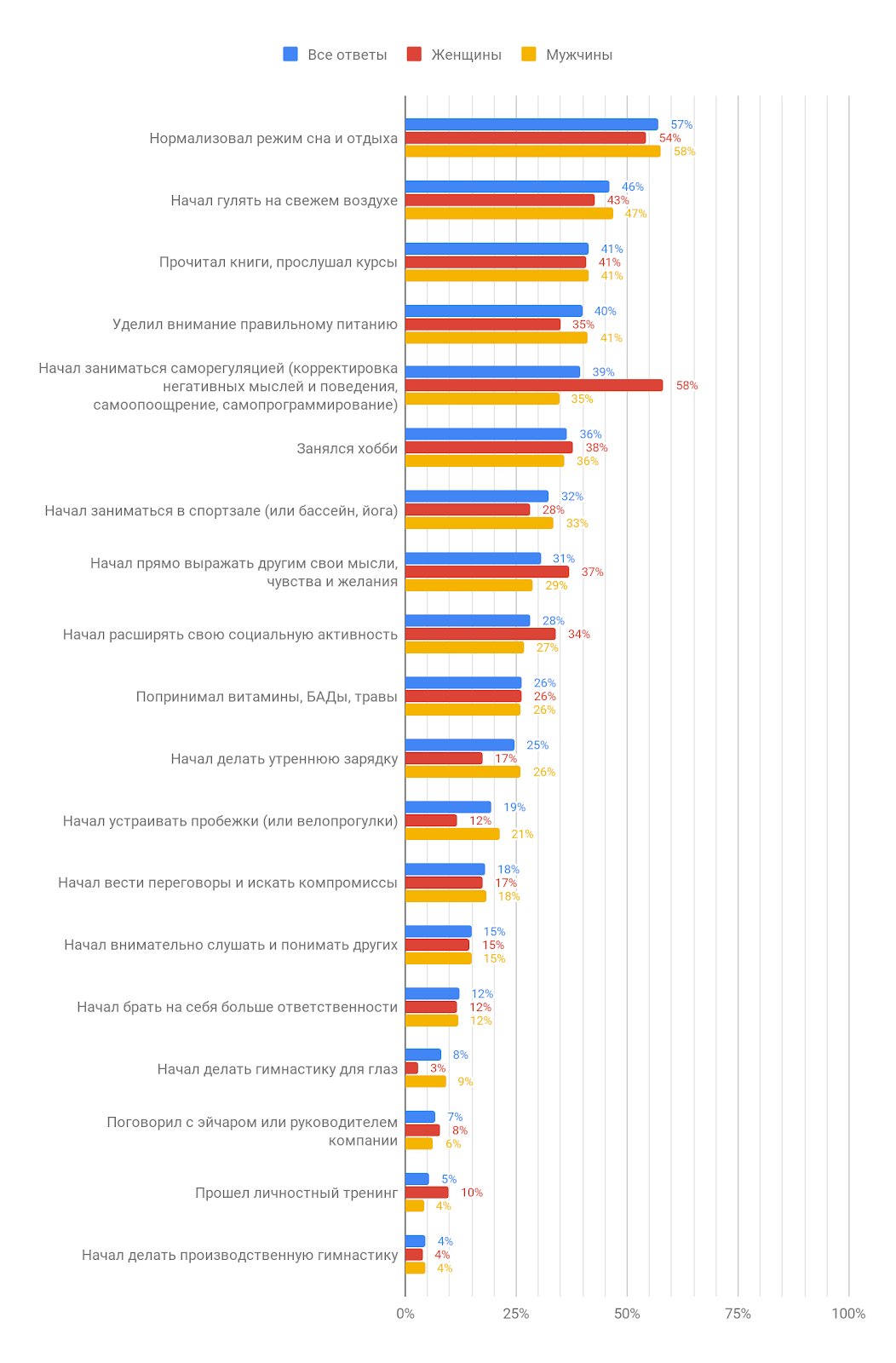
What exactly are your hobbies, leaving the state of professional burnout?
It was interesting to find out, and what kind of hobby those who went out of the fireblow state were carried away. It turned out that most IT professionals start to make music. Next in frequency are the sport, craft and handicrafts, drawing, outdoor activities and ... oh, horror, again programming!
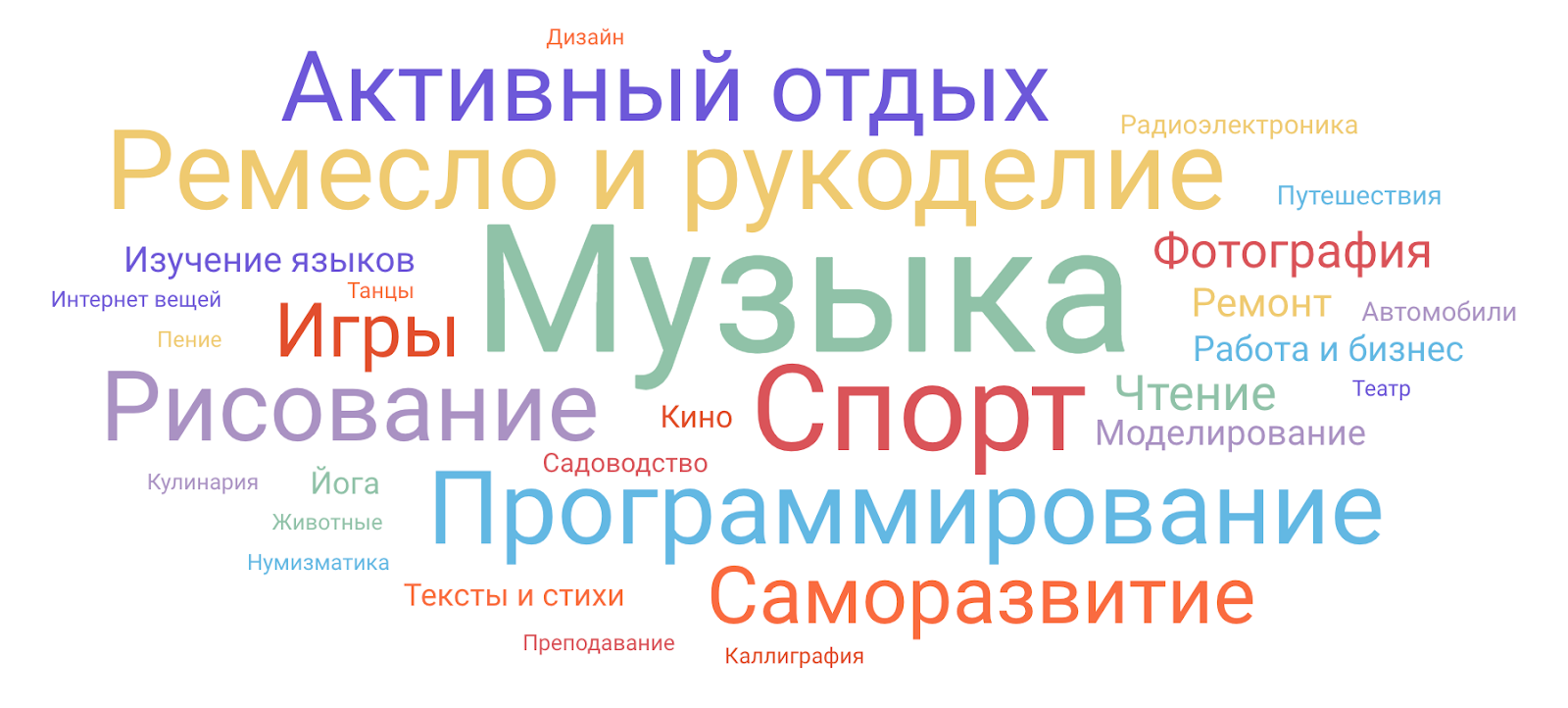
Who exactly of your friends helped you out of a state of severe professional burnout?
Of those who noted the help of friends, the majority turn to their loved ones: two thirds of the respondents noted this. A rather large share, almost half, seeks help from friends. There is no significant difference between women and men when they solve the problem of burning out with the help of their acquaintances.
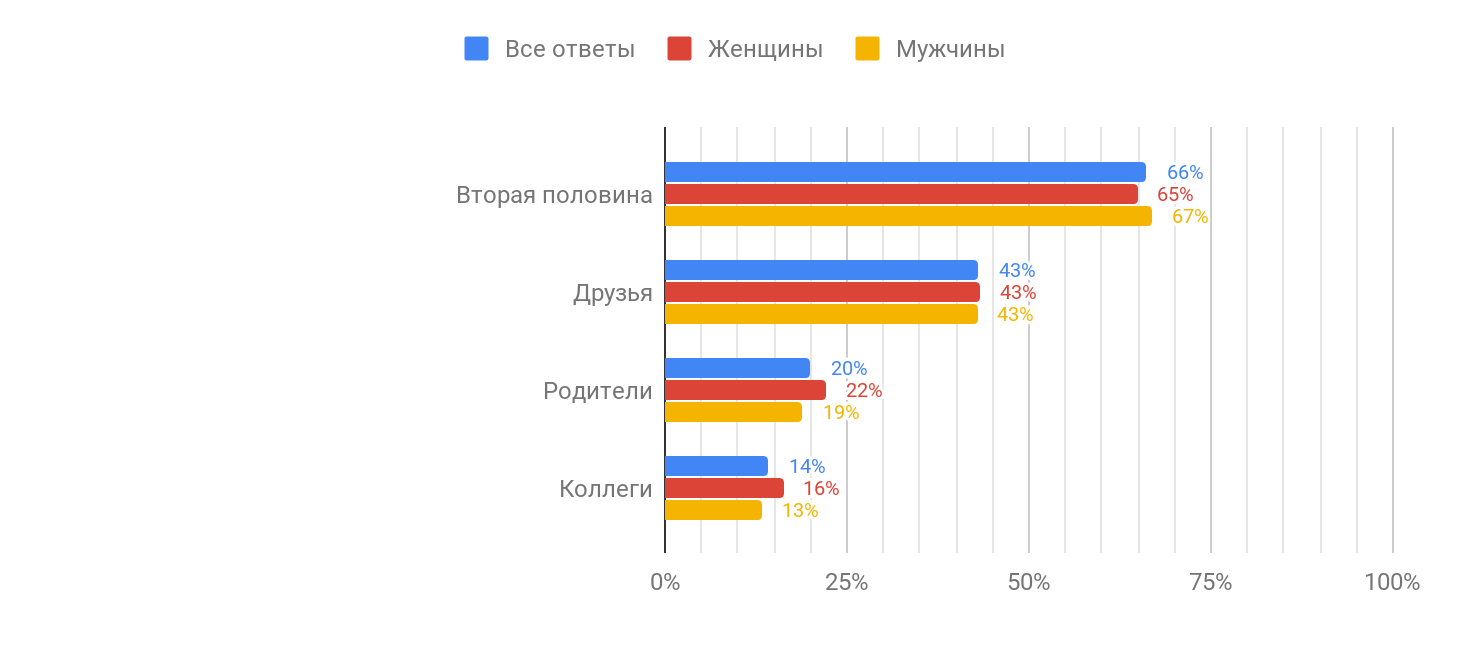
Who exactly of the experts helped you out of a state of severe professional burnout?
Of those who noted the help of specialists, the majority turned to psychologists: two thirds noted this. When referring to specialists, women more often prefer psychological assistance and less often medical or coaching, as compared to men.
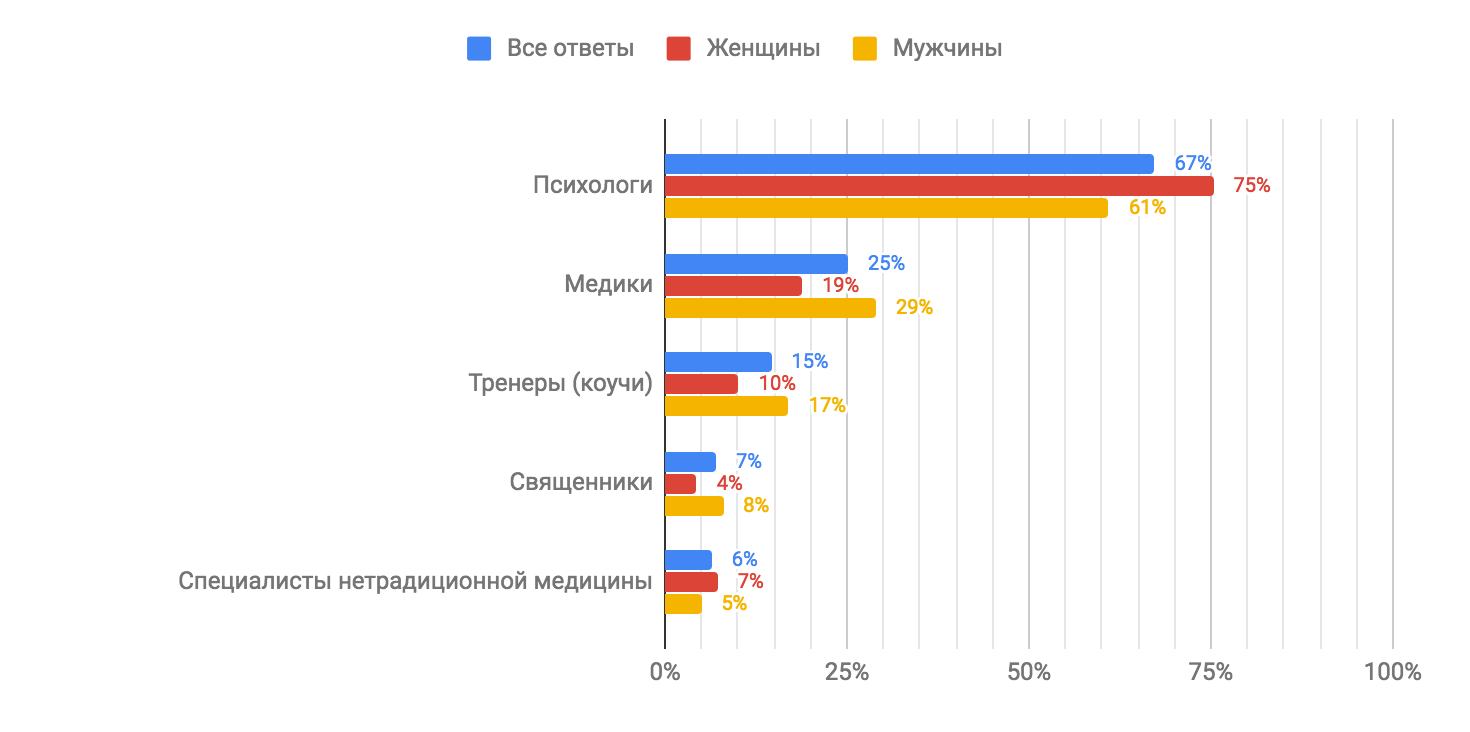
What did the employer do to help you get out of the burnout state?
Among those who noted the help of the employer, the most often called the best distribution of responsibility and the resolution of conflicts: every third pointed out these methods. This is followed by the rationalization of the labor regime and work with the team spirit. All other methods are extremely rare, less than 10%.
In principle, the actions noted more often by others on the part of the employer have something in common with the main organizational destabilizers, which lead to burnout, as we have already seen above.

Let's summarize the last result and list the main ways out of professional burnout, which are used more often than others:
- Self-help : normalization of sleep and rest, psychological self-regulation (especially for women), outdoor activities, self-development, normalization of food, hobbies (music, drawing, craft and handicrafts, outdoor activities, sports).
- Help of friends : contact your other half and friends.
- Employer help : better distribute responsibility, rationalize work patterns, work to increase team spirit and resolve conflicts.
Coming out of burnout, women are more inclined to engage in their psyche, and men with their bodies.
If an employer wants to reduce the likelihood of losing his employees, he must be able to eradicate the causes of burnout, improving organization and working conditions. If the burnout still happened, he should try to help his employee, because those burned out who often not only take care of themselves, but also receive help from the employer, retain their place of work.
The minimum assistance from the employer, in our opinion, is simply that he will educate his employees about the possibility of such negative phenomena. So that at the critical moment the employee could understand what was happening to him and was not afraid to promptly seek help from both the employer and the psychologist.
Watch yourself, be careful.
